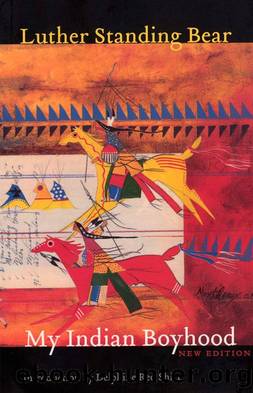My Indian Boyhood by Luther Standing Bear

Author:Luther Standing Bear
Language: eng
Format: epub
ISBN: 978-0-8032-9362-5
Publisher: UNP - Bison Books
Published: 2006-08-14T16:00:00+00:00
CHAPTER V: PLANTS, TREES, AND HERBS
THE world of animal and bird contributed much to the comfort and welfare of the Indian, but so did plant, tree, and herb. The Indian overlooked nothing that might be of service to him. He went deep into the possibilities of all plant life. Simple plants which the white man calls weeds became things of value to the Indian. Some provided a wholesome food, while others were brewed into health-restoring medicines. The white man takes bitter drugs, and pays good prices to another man to give them to him, whereas if he was content to live simply as the Indian does, he probably would have better health. But he disdains Nature and pays for it in hard-earned dollars. Our medicine men were poor, but the white man's medicine men are rich.
Now, one of the most useful of trees to the Sioux was the cottonwood. This tree was used from its top to its roots and from its bark to its heart. The bark was used for all fires where coals were needed. This bark was, in fact, as good as the coal we now use in our stoves. The flame burned without sparks and sputtering, so there was no danger of the tipi catching fire, though in the winter the fire burned all night while the family slept. When the flames had gone down, the coals burned with a steady, penetrating glow that kept the tipi well warmed. Only cottonwood bark was used for heating our paints and for tanning our hides.
Next to the outer bark of the tree was a thin juicy layer of bark, and this we children chewed, as it was sweet and tasty. For all ceremonial purposes the cottonwood was favored. Out of it were made the tripods for sacred articles to hand on, and the cross in the sun dance was made of a cottonwood tree. In the winter, when the snow had covered the grass, a cottonwood tree was cut down and our ponies driven over to feed on its bark. All night these little ponies chewed busily and by morning the branches of the tree would be stripped of bark. Then the tree was ready to be cut up into firewood. The ponies grew fat on this bark, and it was a change of diet for them, although they were industrious and could always find plenty of grass by digging through the snow with their feet.
Cottonwood does not split easily, and when dry is very light in weight. For this reason we made saddles out of it lined with buffalo hide. Neither does the wood bend easily, so we generally used a soft wood like elm for the stirrups. Our spinning-tops we made of the cottonwood, for we spun them on the hard ground or even on the ice in the wintertime and they never chipped nor cracked. It seems rather strange, but the roots of this tree are very light and spongy and will float on the water.
Download
This site does not store any files on its server. We only index and link to content provided by other sites. Please contact the content providers to delete copyright contents if any and email us, we'll remove relevant links or contents immediately.
Melania and Me by Stephanie Winston Wolkoff(1038)
The Class of 83 by Hussain Zaidi(977)
Live in Love by Lauren Akins & Mark Dagostino(960)
Dancing in the Mosque by Homeira Qaderi(930)
Orlando by Virginia Woolf; Mark Hussey(916)
A History of My Brief Body by Billy-Ray Belcourt(887)
Just as I Am by Cicely Tyson(733)
The Schoolgirl Strangler by Katherine Kovacic(731)
Stranger Care by Sarah Sentilles(731)
Virginia Woolf by Between The Acts(730)
Robespierre: A Revolutionary Life by Peter McPhee(719)
Unforgetting by Roberto Lovato(710)
Ariel (english and spanish Text) by Sylvia Plath(705)
1914 by Luciano Canfora(701)
Broken Horses by Brandi Carlile(698)
Paris Without Her: A Memoir by Gregory Curtis(696)
The Common Reader, Book 1 by Virginia Woolf(695)
Berlin Diary: The Journal of a Foreign Correspondent 1934-41 by William L. Shirer & Gordon A. Craig(692)
Harriet Tubman: The Biography by University Press(690)
